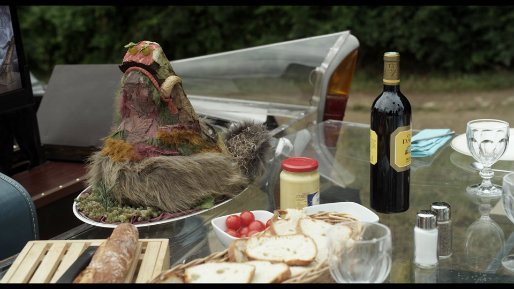There aren’t any specific special foods that are cooked, served, or eaten at a picnic. Picnic food, however, must be transportable. Any food or drink will do, depending on your taste, how much you can carry, and the size of your basket. Eleanor Roosevelt hunched near an open fire, roasting a hot dog on a stick. She makes it look easy, but observers look at her as if she’s a bit nutty, if not undignified for the President of the United States’s wife. 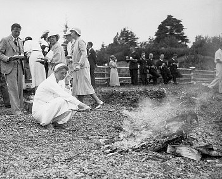
Grahame’s Ratty struggled with a trunk of “cold chicken. . . coldtonguecoldhamcoldbeefpickledgherkinssaladfrenchrollscresssandwichespottedmeatgingerbeerlemonadesodawater——. His wicket is so heavy he struggles to hold it. Easier to deal with is Martin Booth’s A Very Private Gentleman, about Edmund, an obsessive gunsmith/assassin, who packs five grams of pecorino, 100 grams of prosciutto, a jar of small black olives, two oranges, a thermos of sweet black coffee, a loaf of coarse bread, cold bottles of Frascati and Asprinio, and a specially crafted high-powered rifle.
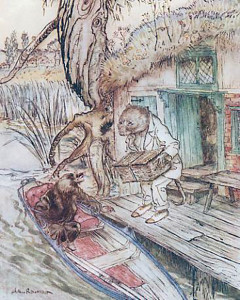
Arthur Rackham. “Shove That Under Your Feet He Observed to the Mole as He Passed it Down into the Boat.” (1931)
Some debate whether the foods should be simple or complex, haute cuisine, for example. Sandwiches or stews? More often debated than what to bring is whether picnic food can be store-bought, home-cooked, or cooked on-site. Manet’s choice for sexual tryst Le Déjeuner sur l’herbe shows no effort for on-site cooking.
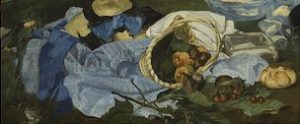
Detail. Manet. Le dejeuner sur l’herbe (1863)
At the earliest picnic-styled meals, repas de pique-nique in 1649, a satirist suggested that a man nicknamed Pique-Nique and Bacchic friends dined in Parisian taverns, where they were highly notable among gourmands. They feasted on ragouts, grillades, ragouts, and cabirotades [stews] and swilling gallons of wine and beer instead of performing acts of martial valor in the War of the Fronde.
About two-hundred and twenty-five years later, during the Franco-Prussian War, Boule de suif, De Maupassant’s courtesan, hid a huge basket under her seat for a three-day coach ride from Rouen to Havre. The basket contained “an enormous dish containing two whole chickens cut into joints and imbedded in jelly . . . pies, fruits dainties of all sorts,” and four bottles, probably wine.
According to Gilbert and Sullivan’s topsy-turvy world, the picnic is unstructured. The picnickers bring soda water, burrage, and sugar to mix with the claret, lettuce for the salad, vinegar for dressing, hard-boiled egg, and salt, but forget the lobster for the lobster salad.
Among the 111 Bills of Fare suggested by Mrs. Beeton in The Book of Household Management, only one is for a picnic –and it’s for the faint-hearted. When carried out as instructed, Beeton’s picnic requires extensive preparation, cooking, serving staff, requisite transportation, and disregard of cost. This: `
- A joint of cold roast beef, a joint of cold boiled beef, 2 ribs of lamb, 2 shoulders of lamb, 4 roast fowls, 2 roast ducks, 1 ham, 1 tongue, 2 veal-and-ham pies, 2 pigeon pies, 6 medium-sized lobsters, 1 piece of collared calf’s head, 18 lettuces, 6 baskets of salad, 6 cucumbers.
- Stewed fruit well sweetened, and put into glass bottles well corked; 3 or 4 dozen plain pastry biscuits to eat with the stewed fruit, 2 dozen fruit turnovers, 4 dozen cheesecakes, 2 cold cabinet puddings in moulds, 2 blancmanges in moulds, a few jam puffs, 1 large cold plum-pudding (this must be good), a few baskets of fresh fruit, 3 dozen plain biscuits, a piece of cheese, 6 lbs. of butter (this, of course, includes the butter for tea), 4 quartern loaves of household broad, 3 dozen rolls, 6 loaves of tin bread (for tea), 2 plain plum cakes, 2 pound cakes,2 sponge cakes, a tin of mixed biscuits, 1/2 lb., of tea. Coffee is not suitable for a picnic, being difficult to make.
Unlike Mrs. Beeton’s suggestion, the Five Chefs’s Picnic in the summer of 1966, organized by Claiborne and Pierre Freney, was cooked and served on the beach of Gardiners Island. Their menu is cooked and served: Mussels Ravigote, Pâté Bluefish au Vin Blanc. Beef Salad, Seviche, Poached Striped Bass with Sauce Rouille, Grilled Squab [fifteen], Cold Stuffed Lobster, Mélange of Fruits. Assorted Cheeses [Brie, Camembert, goat cheese], French Bread, Chablis, Beaujolais Supérieur.
In 1806, John Harris named an outdoor gathering a “pic nic dinner.” The guests were the recently married Cock Robin and Jenny Wren and their guests. Harris followed French rules that each guest contributes something, so Jenny Wren brings her beauty, but Robin brings currant wine and cherry pie. Raven brings a basket of walnuts; Dog brings meaty bone; Owl brings a sack of wheat; Pigeon brings tares (greens); Squirrel offers a bag of nuts; and Magpie carries a piece of cheese. Sheep presents the couple wool for a nest.

Cock Robin and Jenny Wren 1850. Harris gets not credit
Except for Little Mary’s cheese, apples, bacon, and plums contribution. Mary’s presence is usually ignored as an intrusion. She only appears once and is not shown at the picnic cloth with the other animals.
The unappetizing food suggests there aren’t any picnic food perquisites. A picnic menu is limited by one’s imagination, expense, preparation, and appetite. Preference for choices is influenced by social class, race, ethnicity, wealth, and education. Stuffed in wickers, hampers, bags, etc., anything is fair game at a picnic. How much for a picnic is also a matter of choice. For his three-day picnic binge, W.C. Fields is supposed to pack watercress, chopped olives and nuts, tongue, peanut butter, strawberry preserves, deviled eggs, spiced ham sandwiches, celery stuffed with Roquefort cheese, black caviar, pâté de foie gras, anchovies; smoked oysters, baby shrimps, and crabmeat, tinned lobster, potted chicken and turkey, Swiss, Liederkranz, and camembert cheeses, olives, three or four jars of glazed fruit, angel food and devil’s food cakes, gin, wine, and a case of Lanson champagne.
Brillat-Savarin enjoyed traditional midday luncheons or haltes de chasse and described them in “Meditation XV” in Physiologie du Gout or The Psychology of Taste. He knew the pleasures of dining depended on all the food and wines being carried or delivered to a designated trysting place where luncheon during the hunt might be had in two ways: informal, sophisticated, and festive. Of the former, when hunters a trysting place, they pause and snack while waiting for their wives, lovers, and friends to arrive. “Shade attracts him; the turf receives him; the murmur of the rivulet advises him to open the flask he has brought to revive himself with. Thus placed, he takes out the little well-baked loaves, uncovers the cold chicken some kind hand has placed in his haversack, and finds the piece of Gruyere or Roquefort, which is to represent a dessert.” In a footnote, Brillat–Savarin says that he prefers white wine because it “resists heat better than any other.” place where luncheon during the hunt might be had in two ways: one informal, and the other sophisticated and festive. Of the former, when hunters a trysting place, they pause and snack while waiting for their wives, lovers, and friends to arrive. “Shade attracts him; the turf receives him, the murmur of the rivulet advises him to open the flask he has brought to revive himself with. Thus placed, he takes out the little well-baked loaves, uncovers the cold chicken some kind hand has placed in his haversack, and finds the piece of Gruyere or Roquefort, which is to represent a dessert.” In a footnote, Brillat–Savarin says that he prefers white wine because it “resists heat better than any other.”
The halte de chasse’s festive portion begins when the caléches, the hunters’ women, and other friends arrive. As the crowd mingles, staff spreads pâtés de Perigord, the wonders of Strasbourg [charcuterie], the delicacies of d’Achard [patisseries from Chez Achard], and all that the best laboratories [kitchens] produce that is transportable. Instead of the tepid wine carried in backpacks, staff provides “foaming champagne, and “Corks fly,” he assures readers, “all laugh, jest, and are happy.”
Maurice Baring’s drama Caligula’s Picnic sarcastically suggests a picnic dish of eels, a recipe that is among the earliest in a European cookbook, in Le Viandier by Taillevent (1373-1380). In The Song of the Lark (1915), Willa Cather’s picnickers eat fried chicken, deviled eggs, and pickles. Mrs. Abby Fisher’s fried chicken recipe in What Mrs. Fisher Knows About Old Southern Cooking, Soups, Pickles, etc. is standard, but she does not suggest that it’s a picnic food, just a good food eaten anywhere that was left for
Linda Larned’s One Hundred Picnic Suggestions the first cookbook dedicated to picnics. She does not recommend cooking out. Her suggestions are for foods and drinks requiring preparation anywhere but at a picnic. She divides her food into things for a picnic basket or a “motor hamper.” That implies motorists are more food-savvy and richer. There are many suggestions for cold sandwiches and salads, but for motorists, she’s enthusiastic about hot foods. Instead of tuna or ham sandwiches, she suggests lobster creole, calf’s liver terrapin, or deep-fried cheese cutlets.
Ford Maddox Ford’s travelogue in Provence describes a picnic on a Mediterranean calanque, a rocky inlet like a fjord, at which fifteen prodigal picnickers consumed fifty pounds of bouillabaisse, twelve cocks stewed in wine with innumerable savoury herbs, “a salad as big as a cart-wheel,” sweet-cream cheese with a sauce made of marc and sweetherbs, apples, peaches, figs, and fresh grapes.
Elizabeth David’s Summer Cooking (1955) describes her picnic in France just after the end of World War II. Everything was store-bought: olives, anchovies, salami sausages, pâtés, yards of bread, smoked fish, fruit, cheese, and “cheap red wine.”
James Beard’s Menus for Entertaining suggests that a “Festive Country or Beach Picnic for –8” to be served with attractive plates, good cutlery, and crystal, and includes stuffed tomatoes, veal and pork terrine, beef a la Mode Gelée, potato salad or green salad, French bread, butter, cheese, fruit, angel food cake. Beverages suggested include lightly cooled Beaujolais or California red, cognac, and kirsch to go with a great hot or iced coffee vacuum bottle.
Nika Hazleton’s favorite place to picnic is in ruins. In The Picnic Book, she says, “of all of the picnic sites in the world, a set of handsome ruins …appeals to me most.” Her menu and recipes for a picnic in ruins include Smoked Trout, Leaves of Bibb Lettuce Stuffed with Cream Cheese, Cold Sliced Steak, and Cucumber Stuffed with Tomatoes, Mushroom Salad, French Bread, Bitter Chocolate, and Fresh Apricots. (Can you see Sylvia Plath carrying this along for her picnic in “Colossus”?)
Constance Spry and Rosemary Hume’s The Constance Spry Cookery Book put little stock in Mrs. Beeton and curtly suggest that elaborate picnic baskets are “just transported meals—plate, food, champagne, and footmen all complete. This is not the best way to enjoy a picnic.” For those seeking more relaxed suggestions, Spry and Hume suggest a simple picnic of a French Roll with bananas and chutney, a Triple-decker Sandwich, Omlette on a roll, Cornish Pasties, Hamburgers, and Ginger Cake.
Claudia Roden’s Picnic, The Complete Guide To Outdoor Food includes a menu for a picnic at the Glyndebourne Festival Opera, suggested by a friend. It’s an elaborate meal that Roden says is fitting for an elaborate locale. Roden includes recipes for Mousse de Caviare, Chaufroid de canard, Tomates Fracies, Pêches aux fraises, and champagne of your choice.
Alice Waters’ Chez Panisse Menu Cookbook, “Picnic Menu for Six” includes Roasted Red Peppers with Anchovies; Potato and Truffle Salad; Hard-Cooked Quail Eggs; Marinated cheese with Olives and whole Garlic; Roasted Pigeon and purple grapes; Sourdough Bread and Parsley Butter; Lindsey’s Almond Tart; Nectarines; and red or white French wines with the meal and a Provençal, Muscat Beaunes-de-Venise with the dessert.
At our picnics with family and friends, it is expected edibles should be available. But in the arts, food and drink are often ornamental and uneaten. Sometimes, it’s the act of picnicking that matters visually, and food is entirely missing. Rather bizarre is the picnic for Colin and Chloe in Michel Gondry’s Mood Indigo. Only a picture does justice. Walt Disney’s Mickey Mouse is a traditionalist. He and Minnie Mouse have brought hotdogs and rolls to grill.
Preparation and service of picnic foods may be casual or formal. Mostly, picnic foods are served all at once. James Beard, who weighed 300 pounds or more, seriously suggests a “Festive Country or Beach Picnic for –8” to be served with attractive plates, good cutlery, and crystal, and includes stuffed tomatoes, veal, and pork terrine, beef á la Mode Gelée, potato salad or green salad, French bread, butter, cheese, fruit, angel food cake. Companion beverages should be lightly cooled Beaujolais or California red, cognac, and kirsch to go with the cake and a great vacuum bottle of hot or iced coffee.
Mrs. Beeton’s forty-person picnic was, no doubt, served by staff. Dickens jokes in The Pickwick Papers that the gracious Wardles family is served a picnic lunch of cold fowls, pigeon pie, veal, ham, tongue, lobster salad, and wine in their barouche. More down-to-earth, Sophie Zawistowska, the hero of Sophie’s Choice, is partial to pickled eggs, salami, pumpernickel, Bratwurst, Braunschweiger, sardines, hot pastrami, bagels, and lox.
Gertrude Stein and Alice Toklas’s picnics ended at a restaurant where they might dine at Morvan Ham with Cream Sauce, three-minute veal steak, grilled perch with fennel, puree of artichoke soup or bouillabaisse.
When William Blanchard Jerrold discovers the novelty of a store-bought picnic, he approaches the menu with heavy humor. “Picnic Reform,” The Epicure’s Yearbook for 1869 (London, 1869), exclaims “Aha! Moment” when he realizes his local West End London food emporium was his best picnic food source. He calls this new picnic fare “Potted Luck” because it all comes in tins. “The success of our Temple experiment led to its repetition on other occasions.” Jerrold brags. “It was agreed that the plan might be extended to picnics and races and that henceforth, instead of the hampers of heavy ill-packed meats, etc., which the Englishman has been wont to carry for consumption al fresco; he might have light and seasonable delicacies, and for instance, at a picnic, arrange a menu to which the various guests might bring their appointed contributions in the smallest possible compass, and without risk of damage.” For comic exaggeration, Jerrold suggests purchasing stuff like “Potage—Crecy. Vermouth de Turin, Hors d’oeuvres. — Salade d’anchois; salade de homard; caviare; saucisson de Brunswick; saucisson de Strasbourg aux truffes; anchois frais; ecrevisse; potted tongue. . .” and much more.
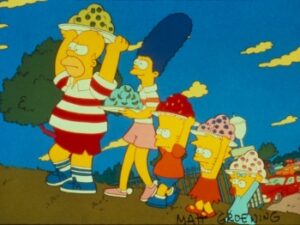
Next to last is this Simpsons’s dessert they contribute to Mr. Bruns’s company picnic. In fact, all of the picnickers attending bring jello mold because the jello. Everyone wants to please Burns But contrary to what they believe, Burns hates jello mold and trashes all of them.
Last, for now, is Sam Weller’s explanation of “weal pies,” which Dickens wrote about in Pickwick Papers. “Wery good thing is weal pie,” Weller says, “when you know the lady as made it, and is quite sure it ain’t kittens; and arter all though, where’s the odds, when they’re so like weal that the wery piemen themselves don’t know the difference?
‘Don’t they, Sam?’ said Mr. Pickwick
Whether or not Pickwick understands Weller is questionable. He’s been drinking steadily and is so drunk he cannot stand.
Featured Image: The picnic feast is purposely surrealistic and unappetizing. Michel Gondry’s Mood Indigo (2013)

